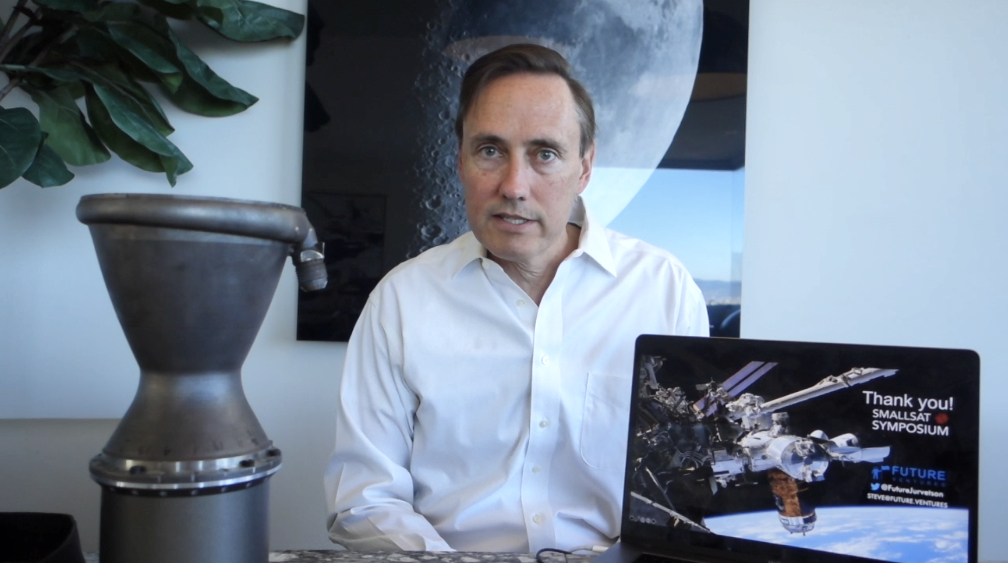
With an Astra 3D printed engine all fired up to his left, Steve Jurvetson of Future Ventures presented his keynote presentation during the first day of the SmallSat Symposium.

He noted the fact that the Astra smallsat engine is “really that small” and that thy just went public via a merger into SPAC and raised $500 million on a $2 billion valuation.

Steve also showed the largest slice of the moon, a lunar meteorite, that he looks at each day as it brings him great joy. “I’m just geeking out on space today,” he added.
He continued by noting that there is a revolution underway in smallsats, satellite constellations and mega-constellations and he wanted to share some of the enthusiasm his firm has for this sector. His company, Future Ventures, has only invested in two space companies, those being SpaceX and Planet, and they are incredibly exciting.
As a venture capitalist, Mr. Jurvetson served on the board of both SpaceX and Planet Labs for many years. “Frankly, startups, new entrants, they all do meaningful innovation,” he said. “Just a general statement in business, that is, perhaps, without exception, every meaningful advance, every advance in the history books that have been written about, every change to a core business, is led by new entrants, not by an incumbent. So don’t expect any difference in the space industry. Startups in this business are important, because that’s where the future may lay.”
Mr. Jurvetson animatedly said there is certainly something afoot, something exciting in the air, anticipation, across many fronts, and he believes that can largely be credited to SpaceX and those others who are following, copying, and hoping to do something competitive to SpaceX, as well. All great for the satellite business. “If you are in the business of cloud services or internet services, and somebody radically lowers the cost of access, via fiber or Starlink or whatever may be, if you’re a cloud services provider, this is great. So, the same for satellite businesses. If you want to launch satellites to orbit, there’s nothing better than SpaceX and 150 competitors trying to do that for you.”
He said it was pretty amazing how much worked for SpaceX the first time in the company’s design stack. “Why might that be?” he asked. “I think the answer really resides with software. The fundamental competitive advantage of SpaceX, Tesla, Planet Labs, is their software stack and a system engineering realization — not a component subsystem realization — but a system level engineering of a product around a software modality, the same way the iPhone just re-ran away with the entire mobile phone business.”
Steve showed a graph entitled “120 Years of Moore’s Law” that showed how much computational power a dollar can buy… “Realize, humanity’s capacity to compute has been compounding uninterrupted for 120 years. The main takeaway? Computing power doubles every year.”

With reference to the Apollo program, which consumed over half of all semiconductor output of the world, back in its heyday, Steve noted that was all about software. What’s going on now is a mega-trend, not just a space trend.
Over 99 percent of all satellites launched will be part of large constellations, he stated. Smallsats can be flow low and frequently and can take advantage of the latest chips and are, basically, disposable satellites. With a deep nod to Planet Labs, Steve noted that the company manages 3 million images every day and image10x as much as every other commercial and public sources combined.
Back to SpaceX, he mentioned the technically advanced 60 satellite pancake stack and the ability of the rocket to rotate the satellite in orbit to eject the Starlinks from the fairing and into their assigned orbits. No springs required.
He closed by stating there’s never been a better time to be a satellite business person, a satellite entrepreneur, or frankly a customer of any type. There’s incredible change afoot.

Comments from attendees of his keynote were highly positive of Steve’s presentation, calling the video “insightful” to “loaded with facts, full of insights, a most enjoyable 30 minutes” to “best presentation I’ve seen in several years!”
Certainly Mr. Jurvetson’s presentation was one of the most interesting keynotes of this, or any other, space/satellite symposium.

